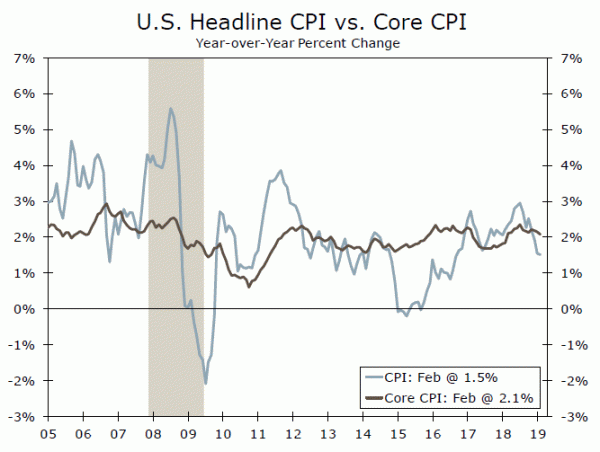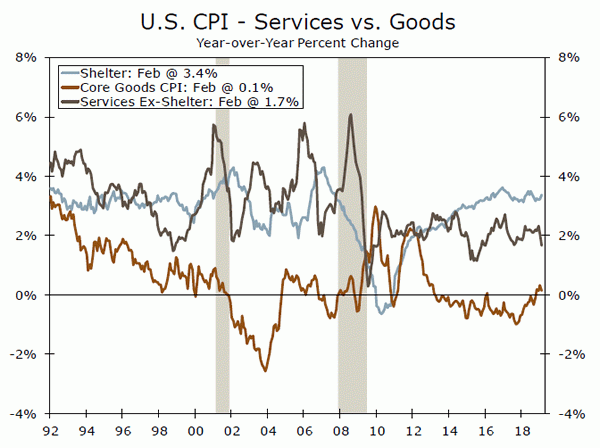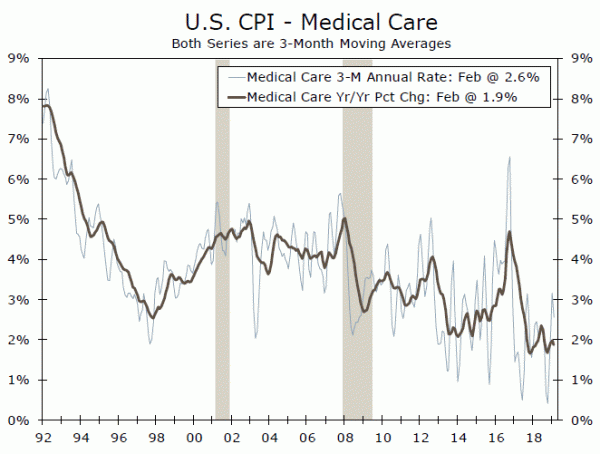Consumer price inflation edged up in February as gas and grocery costs increased. Core prices ticked up 0.1%, keeping the trend near 2%. Nothing in this report suggests the FOMC is likely to adjust its “patient” stance soon.
Gas and Groceries Prices Pick Up in February
Consumer price inflation continues to be fairly tame. The CPI rose 0.2% in February, but slipped to 1.5% on a year-ago basis due to lower energy prices over the past year. Core inflation slowed, but is running at a 2.1% annualized pace over the past three months and on a year-over-year basis, close to the FOMC’s goal.
Higher energy prices over the month lifted the headline. After three straight months of declines, gasoline prices rose 1.5%. Prices are still down 9.1% over the past year, as energy prices have shaved 0.4 points from headline CPI and supported real income growth. With gas prices up about 3% through the first third of March according to AAA, however, the bump to real income from low gas prices is beginning to fade.
Food prices also picked up over the month, with prices for food at home and away both rising 0.4%. That was the largest gain at grocery stores in nearly five years, but likely overstates the trend for the next few months as agricultural commodity prices, which lead grocery prices, remain under pressure. Growing wage costs, however, should keep costs for dining out rising close to a 3% pace.
Core Inflation Slows a Touch
Core inflation eased up a bit in February, as prices rose 0.1% (0.11% before rounding) after five months of 0.2% gains. The weaker print can be traced to a drop in core goods prices, which fell 0.2%. That was not wholly surprising— a hefty 1.1% jump in apparel prices in January was going to be tough to repeat, and used car prices (down 0.7%) were due for a pullback, based on the Manheim Used Vehicle index. Lower prices for new vehicles and prescription drugs also dragged down core goods prices.
Services inflation held up better, with prices rising 0.2%. Shelter costs rose 0.3% for a fourth-straight month. Notably, core services were boosted by gains in lodging away from home and airfare—two volatile components— which raises the prospect for payback next month. Prices for services less shelter were flat as gains in education and personal care offset declines in recreation. Medical services prices were flat, keeping the growth trend in consumer healthcare costs historically slow.
No Need Yet for FOMC to Lose Its Patience
While labor costs have been heating up—average hourly earnings growth hit a new cycle high in February—the pass-through to consumer price inflation continues to be only modest. Stronger productivity growth over the past year has kept unit labor costs in check, while historically high profit margins leave companies some scope to absorb higher labor costs. As a result, inflation looks unlikely to get out of hand. That should allow the FOMC to keep its patient stances over the next few months and watch incoming data. We expect the inflation trend to remain firm near 2%.















